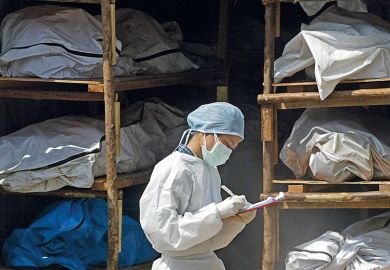Harvard University has counted in its possession the human remains of nearly 7,000 Native Americans and another 19 people who were likely held in slavery, according to an internal assessment described by its student newspaper.
The emerging official tally largely aligns with earlier estimates of the university’s museum collections, although the counting still would leave the university with difficult questions about identifying many thousands more and deciding how best to handle them.
The collections date back at least to the 1800s and were assembled and used for reasons that include historical preservation and aiding research into disease, nutrition and migration. Much of the work was marked by assumptions and assertions of white supremacy.
Harvard’s president, Lawrence Bacow, apologised for such practices after receiving a preliminary review of the situation in January 2021, and ordered the accounting effort now being described by the student newspaper, The Harvard Crimson.
The university did not deny the figures but criticised the Crimson for publishing what the newspaper understood to be a draft version of the planned final report by the panel, known as the Steering Committee on Human Remains in Harvard Museum Collections.
“Releasing this draft is irresponsible reporting,” said the committee’s chair, Evelynn Hammonds, a professor of the history of science, “and robs the committee of finalising its report and associated actions, and puts in jeopardy the thoughtful engagement of the Harvard community in its release.”
Overall, Harvard’s museums have contained the remains of more than 22,000 people. While exceptionally large, it is not unique. Yale University had the remains of 1,100 people its collections, and the University of California, Los Angeles had 124. The Smithsonian Institution, the federally subsidised grouping of museums and research centres in downtown Washington DC, accumulated nearly 30,000.
Such organisations have faced pressure to identify their origins and return them to descendants or their communities as quickly as possible. At Harvard, that is a job about one-third complete and is expected to take another decade or more.
The steering committee, in the draft report described by the Crimson, calls the collection of human remains “a striking representation of structural and institutional racism and its long half-life”. It urges the university to work as hard as possible on identifying people individually, as much as possible.
The preliminary assessment that led Professor Bacow to create the committee had identified the remains of at least 15 people as having African descent and dating to the period of slavery. The committee, according to the draft report, added to that list another four people from the Caribbean and Brazil who likely also had been held in slavery.
Register to continue
Why register?
- Registration is free and only takes a moment
- Once registered, you can read 3 articles a month
- Sign up for our newsletter
Subscribe
Or subscribe for unlimited access to:
- Unlimited access to news, views, insights & reviews
- Digital editions
- Digital access to THE’s university and college rankings analysis
Already registered or a current subscriber? Login








